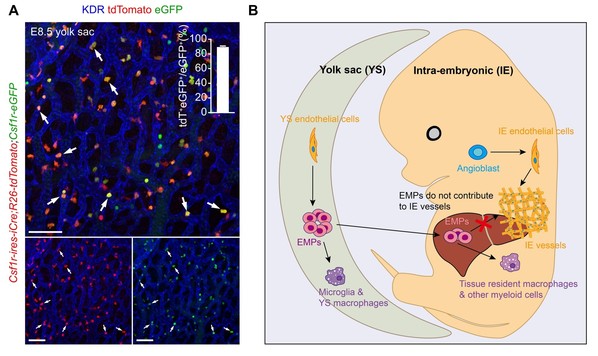A research team led by Professor Zhang Hui from School of Life Science and Technology (SLST) at ShanghaiTech University has demonstrated that erythro-myeloid progenitors (EMPs) are the origin of resident macrophages in multiple organs, but not the origin of intraembryonic vascular endothelial cells. The team has written an article entitled “No Evidence for Erythro-Myeloid Progenitor-Derived Vascular Endothelial Cells in Multiple Organs” which was published online in the journal Circulation Research on August 14, 2020.
Furthermore, this work reveals that mesodermal-derived angioblasts are the main origin of intraembryonic vascular endothelial cells. This study has solved the controversy over the origin of embryonic blood vessels and is of great significance for understanding vascular development and advancing cardiovascular regenerative medicine research.
The intraembryonic endothelial cells are thought to emerge de novo via the assembly of mesodermal-derived angioblasts at early embryonic stage. The early endothelial cells first differentiate into a primitive vascular plexus and then form the whole vascular system. Besides angioblasts, EMPs have been recently proposed to be another remarkable developmental origin for blood vessels in multiple organs including the hindbrain, liver, lung and heart. This conclusion challenges the current consensus that intraembryonic vascular endothelial cells are self-sufficient and able to expand without non-endothelial contribution.
To solve the controversy, Professor Zhang and his colleagues used different Cre mouse lines, such as Csf1r-Mer-iCre-Mer, Csf1r-ires-iCre and CD45-iCre, and performed lineage tracing studies to examine the cell fates of EMPs during development. They demonstrated that EMPs do not contribute to vascular endothelial cells in brain, liver, heart and lung during development.
Doctoral students Feng Teng and Gao Zibei are the co-first authors. This work was sponsored by grants from the National key R&D Program of China, National Science Foundation of China, the “Shuguang Program” supported by Shanghai Education Development Foundation and Shanghai Municipal Commission, Shanghai Rising-Star Program, and the ShanghaiTech University start-up fund.
Article link:
https://www.ahajournals.org/doi/abs/10.1161/CIRCRESAHA.120.317442

EMPs do not contribute to intraembryonic vascular endothelial cells. A. Csf1r-ires-iCre;R26-tdTomato mouse line efficiently labels Csf1r+ cells in yolk sac at embryonic day 8.5. Csf1r is a marker of EMPs. B. A schematic figure showing the cell fates of EMPs.


